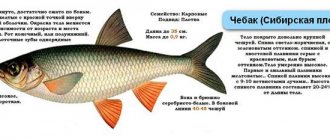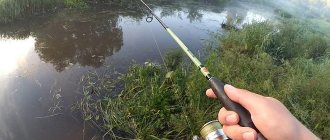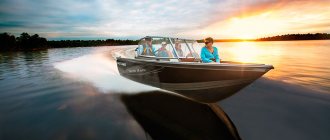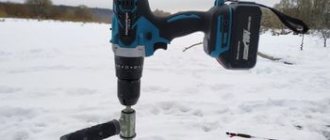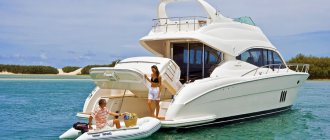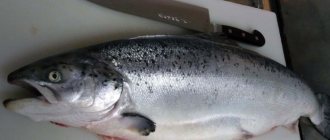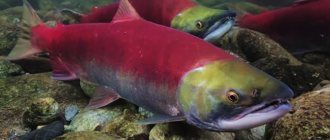Night fishing, catching fish with a net
Beaming fish, in my opinion, is the most exciting way of fishing, fishing takes place at night, this already adds romanticism and mystery...
I’ll say right away that in this type of fishing I used not a spear, but a net.
This type of fishing is prohibited by the Fishing Rules as poaching, but I would like to argue, since a net does not injure the fish.
If, in the case of fishing with a spear, a lot of fish are damaged and simply die in the future, then it will not be possible to injure the fish with a net and it will leave unharmed.
I don’t know a more exciting and exciting way to catch fish
Yes, about the excitement - think for yourself, you’re walking along the river and in the beam of a flashlight you see a fish standing, the hunt has begun...
Every time everything happens differently, different fish, different sizes, different bottom topography, which is very important, since the net is pressed to the bottom, depth, the soil at the bottom is of great importance, and a lot of other nuances.
You have to learn this method; rarely does anyone succeed the first time, but after several nights spent on the river, mastery will come on its own and you won’t be left without fish.
And what a delight, buzz or something else you feel, words cannot describe when you feel the weight in the net and how the prey is beating.
They showed me this method of fishing in 1992, I was fishing on mountain taiga rivers in the north of the Republic of Buryatia, BAM zone.
Most often I wandered along the Muya River, where there are large sand spits - an ideal place for casting a net. Usually I caught grayling and valka (whitefish), as well as small-sized fish (like capelin) tugun (also a whitefish).
Sometimes, taimen and lenka were found, but less often. In the early 90s, there were a lot of fish there, as well as rayfish; on Saturday night, sections of the river shone with the lights of lanterns like New Year trees.
Perhaps the general decline in the standard of living of many families in those hard years also had an effect, so they tried to survive on fish. In short, on the banks of the river there were people like on city streets, they walked along the spits one after another and, strangely, there was enough fish for everyone, no one was left without a catch.
In the last 5-6 years, the fish have left those places almost completely; we began to notice that there were fewer fish in the early 2000s. Most likely, this is due to climate changes in those places.
Winters have become warm, frosts over 40°C are rare. If in the 90s, under a rubberized suit or boots, “swampers” wore “quilted jackets” and woolen socks, otherwise their feet would get cold, but in recent years, you walk along the river at night in a T-shirt and it can even be hot, and the water is warm like milk, and that’s in the end August, early September.
How does the fishing process work?
Let's end this sad digression and move on directly to the process of beaming fish and equipping the fisherman.
You go out onto the river looking like this:
- in a waterproof suit (fisherman's suit or OVZK) or high boots (you can't go deep in boots)
- in one hand - a flashlight (preferably on a belt)
- in the other - a net
- a bag or box for catch on a shoulder strap, hanging slightly below the waist.
At that time we used miner's flashlights; they shined beautifully, of course, if they were well charged. With the advent of Chinese consumer goods, they began to switch to brighter flashlights, which held a charge longer and weighed less.
The main thing is that the beam penetrates the water a meter and a half deep; it is no longer required, since you still won’t be able to go that deep. And in terms of distance, the farther it shines, the better, you walk 20 meters from the shore up the river and see everything 180 degrees. As a rule, there are small fish near the shore, but there may also be a good burbot or grayling, and a roller or a timefish is standing on the current and deeper.
The fish is clearly visible, if you illuminate it from the side, you immediately need to move the beam to the side, but so that the object of the hunt is visible and does not scare the fish away with the light (keep it in the shade). Next, you try to quietly approach the fish from the tail, without making any disturbance on the surface, since you can lose sight of it if the fish moves or simply scare it away.
That's it, the net is above the fish, but does not touch it, we make a sharp movement with the net forward and down, covering the prey.
Usually, the fish, trying to free itself, begins to rush under the net and, rising, gets stuck in the narrow conical part of the net - in other words, “motne”, at this moment, you sharply pull the jump out of the water, take out the fish and put it in the bag that you carry with you over your shoulder.
It happens like this - the fish did not react to the fact that it was covered with a net and stands quietly, this very often happens with burbot, lies like a cat and slightly moves its tail.
We try, without lifting the net from the bottom, to move it, this is most often enough for the prey to start rushing about, but there have been cases when we had to kick it with a boot.
It’s very inconvenient to fish from a boat with a net, and it’s difficult to row against the current, so you go into the river in a waterproof suit and wade up, usually we walked 3-4 kilometers during the night, if there were few fish, we moved to other places where there were long streams .
This kind of fishing is very dependent on the weather, that is, if the wind blows, then there are ripples on the water, and therefore nothing can be seen, the same thing in the rain.
Now it's time to tell you how to make a net
Making a net
To make a net you will need:
- mesh with a mesh of 10 x 10 mm (5 x 5 mm is also possible) canvas size is approximately 1200 x 1200 mm (very good if you have a ready-made connected net or some kind of mesh blank)
- steel, springy wire with a diameter of 3 ÷ 4 mm, a meter and a half long.
- steel pipe with a diameter of 25 ÷ 30 mm and a length of 25 ÷ 30 cm
The influence of light on fish biting - the opinion of science
The influence of light on fish biting . The use of artificial light to attract fish has become widespread in industrial fishing. Using the “light” method, many important species of commercial fish are caught in our country and abroad, and netless fishing methods were developed back in Soviet times! But ichthyologists became interested in the biological basis for such a phenomenon as the attraction of fish to light not so long ago.
For fishermen whose catches are far from commercial, it would be more useful to understand the biological basis of attracting fish to different light waves and try to apply their knowledge in practice! The first question that arises is: what is the spectrum of light perceived by fish? The sensation of light in fish is caused by a small portion of the electromagnetic wave scale.
For humans, this scale lies between 400 and 760 nm. It is generally believed that the scale of light perception in fish is the same as in humans. Therefore, when fish are exposed to electromagnetic waves in the range of 400-760 nm, it is understood that such waves are perceived as light. In fact, this is far from the case! Ichthyologists have already established that the scales of light perception in different species of fish are very different.
In fish that live in the upper horizons of water (that is, in conditions of the fullest light spectrum), the light-acceptance scales are the widest and approach those of humans! And in fish that live at depths (in conditions of a relatively poor spectral composition of light), the maximum light perception usually occurs in the short-wave region of the spectrum.
In addition, it should be remembered that the light used by anglers and perceived by fish can vary greatly. This applies not only to individual parts of the spectrum, some of which are not perceived by fish at all, but also to the effectiveness of the entire radiation of individual light sources.
The light that is usually used in modern fishing and in experiments is usually the radiation of incandescent lamps, in the spectrum of which the maximum energy falls on long waves. Most of the radiation energy is ineffective because it is not perceived by the fish. This point was not taken into account in fishing lighting devices, and they turned out to be ineffective and uneconomical.
In many fish (for example, Caspian sprat, which are actively caught using lamps), the positive reaction to light increases as the brightness of the attracting light increases. In practice, optimal light sources should be with a maximum luminous efficiency in the region of 500-550 nm (the first type of lamps) and with a maximum luminous efficiency in the region of 550-600 nm (the second type of lamps).
For these reasons, the use of luminous phosphors of constant and variable action, which can be used to color artificial baits, is promising for amateur fishermen. Using light compositions with various phosphors, their spectral radiation can be selected in accordance with the spectrum of light perceived by fish. The disadvantage of luminous phosphors is their low brightness.
Often, in experiments to attract fish to light, it is advisable to use radiation that is not directly perceived by fish. This refers to “near” ultraviolet radiation (400-300 nm), which can cause fluorescence in organic and inorganic suspended matter in water. The same glow is observed during the massive development of luminous planktonic organisms, which often serve as food for fish.
This glow is not only well perceived by fish, but is also associated by some fish with a massive accumulation of planktonic food organisms. So you can try experimenting with different fluorescent lures.
It is not necessary to buy such bait in specialized stores; it can be made at home from various fluorescent materials and individually selected for each fish. Just don’t use white phosphorus - you’ll poison yourself and the fish. The threshold sensitivity of the fish eye to the brightness of light depends on the conditions of their preliminary adaptation to light or darkness.
The threshold sensitivity of the retina of various fish to the brightness of light, previously exposed to darkness for 1 hour, approaches 109 lux, and for the same fish exposed to bright sunlight for 1 hour, it drops to 102 lux. The sensitivity of fish to light brightness can vary a million or even tens of millions of times.
It is natural, therefore, that the optimal amount of attractive light varies depending on the brightness of the surrounding background lighting. So, armed with flashlights and other luminous and fluorescent devices, look first at the sky. Assess the degree of illumination in the area and how long such illumination was observed.
After all, the optimal value of the attractive brightness of light lies between two brightnesses that have opposite effects on fish: the threshold brightness of light, which causes an indicative reaction in fish, and the brightness of blinding light, which causes the fish to leave. The reaction of fish to artificial light depends on the conditions of preliminary adaptation to light.
This is especially clearly manifested in the change in reaction to artificial light under the influence of lunar illumination. Let's take the sea as an example. On moonless starry nights, the illumination on the sea surface, depending on cloud cover, ranges from 104 to 103 lux, and at this level of adaptation, the illumination of the attracting light reaches approximately 10 lux.
On moonlit nights, the illumination on the sea surface ranges from 101 to 102 lux, while the illumination of the attracting light already reaches a value of more than 100 lux. From a biological point of view, such a sharp difference in sensitivity to light brightness in fish adapted to lunar or moonless night illumination is associated with a restructuring of the light-perceiving apparatus of the retina.
At background illumination from 101 to 102 lux and above, a transition occurs to less sensitive cone vision (light adaptation), and at illumination levels below 10 lux, to more sensitive rod vision (dark adaptation). In this regard, under moonlight, the sensitivity of fish to the brightness of light sources and an increase in the magnitude of attracting light decreases.
As a result, the area of attraction of light decreases, and this leads to a decrease in fish catches. However, the fact that on moonlit nights an angler brings home a pitiful catch is not only due to a decrease in the brightness of the bait under the influence of moonlight. The reason for the decrease in the effectiveness of attracting fish to light under the moon is a general change in the behavior of fish.
During the full moon, many fish begin to form schools and actively feed, as a result of which the signaling value of the artificial light source is significantly weakened. Its brightness under the moon can be increased somewhat by using colored light in the short-wave region of the spectrum, for example, green.
Such colored lighting is contrasting compared to moonlight, and it can be created using both incandescent lamps and appropriate light filters, as well as special emitters. The quality of the attractive light depends on the fish's ability to distinguish colors. For example, the reaction of juvenile sturgeon is most pronounced to the green-yellow part of the spectrum (550-570 nm).
The reaction is weakest in the orange-red and blue-violet regions of the spectrum. These results were the same under both dark and light adaptation conditions. In horse mackerel, when “white” light was passed through a red filter, which reduced the light energy five times, the reaction not only did not weaken, but even increased! So, buy a Chinese laser pointer at any kiosk - and go ahead and buy horse mackerel.
The advisability of using colored light to attract fish is related to the ability of the retina of its eye to distinguish or not to distinguish colors. Conclusion: Fish with color vision exhibit a positive light response to colored lighting. Colored light of a certain brightness is a signal that attracts fish.
Under natural conditions, sunlight reaches certain fish living at different water levels, having undergone a certain qualitative and quantitative filtration. Thus, already in the first 10 m of water, red, then orange, yellow and green-yellow rays fall out of the solar spectrum of light and a significant weakening of light occurs.
The remaining sunlight therefore acquires a certain color and intensity, with which in different fish the manifestation of different forms of life activity is in one way or another connected (shoal formation, feeding, vertical migrations, avoidance of enemies, etc.). Naturally, the color and intensity of a particular water lighting acquire a certain signaling value for fish.
That is why the greatest attracting effect on horse mackerel is exerted by low-intensity orange-red light, which is associated with the morning coloring of the upper water horizons, under which conditions this fish forms and feeds. The same pattern can be observed in other fish. And finally, about the pros and cons of various “light catchers”.
The use of “white light” lamps with constant brightness has the following disadvantages: the strong intensity of the light sources does not allow many species of fish to approach and concentrate near them, most fish stay away from light sources, in a certain lighting area; “white light” contains both sections of the spectrum to which a given species has the most pronounced positive reaction, and sections of the spectrum with an indifferent or negative reaction to them.
Pros: the ability to create a very intense light that can penetrate deep into the water; positive reaction of all light-loving fish to relatively low lighting.
The use of combined light sources (incandescent “white light” lamps together with light filters or monochromatic emitters) has the following disadvantages: these sources have low light intensity (brightness); These radiations are strongly absorbed in the water and, as a result, the radius of attraction sharply decreases and the area being fished is reduced.
Pros: causes a strong positive reaction in fish. The ideal is the combined use of both types of light traps. By the way, it has been noticed that many fish react more clearly to the constant light of torches (or fires) than to incandescent lamps. So take flashlights, lamps, color filters, lasers (if you are a brave innovator), torches (if you are a cautious conservative) and good luck with your fishing!
Author Ekaterina Nikolaeva
Fishing with a red lantern
We all love funny stories about fishing and fishermen, but this incident, although very old, is real and our company doesn’t really like to talk about it, it’s a little embarrassing to remember.
And everything happened like this. We gathered in a small group of five for fishing. We settled down on the shore of a very beautiful lake, as usual, set up a camp table, of course, drank a little, how could we do without it, and began to prepare our gear. And then, like in a fairy tale, out of nowhere, a grandfather appeared in an old, worn-out military jacket, and instead of a leg he had a prosthetic. The old man's chest was decorated with order bars, and he had a cap on his head.
Smiling, the grandfather said: “Have you come to fish? It's late, sons, it's late! There are no fish in this lake anymore - last year poachers killed them all with electric fishing rods. You’ll just work in vain, you’ll…” What can I say, our mood, of course, plummeted. We invited grandfather to sit with us, eat and drink. At first he resisted, he kept talking about his poor health, but then he gave in. He sat down at our makeshift table, drank one glass, another, a third... From his appearance we understood that grandfather wanted to tell us something, but could not decide.
But finally, the old man decided: Sons, I see that you are good people, so I decided to tell you a secret. But swear not to tell anyone about him. Otherwise, if my fellow countrymen find out, I’ll be in trouble. Of course, there are no fish here, but there is something even better - crayfish of this size! – Grandfather spread his arms more than half a meter. If you know the secret of catching them, you can catch five bags in a night. And the secret is simple. Then grandfather began to tell us in detail in a low voice.
The gear offered by my grandfather included an old large boiler, a board and a red lantern. The old evaporation must be installed on the shore, next to the water, and one end of the board should be directed into the water, and the other should be placed on the edge of this evaporation. The lantern had to be placed a little behind the boiling water, so that the light of the red lantern was directed towards the lake. “You will take the waste from an old trash can, break a board from my personal fence, and install a flashlight and battery from your car,” the grandfather advised. At night, the crayfish, attracted by the light of the lantern, will begin to crawl along the board and then fall into your boiling water.
Just remember, under no circumstances should you joke or laugh. As soon as the boil is full of crayfish, you take them out and put them in bags moistened with water, and then in the grass, where they will be alive and fresh for a long time. Although I see that you don’t even have bags. But that's not a problem, I'll sell you mine. “Grandfather, maybe we should try fishing and throw in our gear?” we asked. Over there on the other side of the lake, some fishermen are already apparently fishing. “Then the fools are sitting there, they don’t even realize that there are no fish here. And if you throw away the gear, the crayfish will get scared, crawl into holes and not come out, and you will be completely left without a catch,” the grandfather muttered angrily.
Key characteristics of the device
A fishing headlamp serves as a source of light flux, which allows fishermen to properly organize night lighting of the place. Fans of night fishing can easily see the fishing point and change the bait. The device has small dimensions, so it can easily fit into a bag or backpack. It illuminates the area perfectly without consuming much energy. For a pastime such as fishing, such a device must be quite productive and reliable.
The flashlight is placed on a person's head using an elastic band or strap . The luminous flux of such a lantern is always directed in the direction where the gaze is directed. A person has to turn his head to direct the light beam to the right place. In part, this is the only drawback of the flashlight that you have to put up with. The obvious advantages of this flashlight outweigh the minor drawback many times over.
Flashlights may differ in quality and price, so it is important to know the most basic and important characteristics of the device, which will become useful during its operation. Flashlights from trusted manufacturers have the most favorable technical indicators of this device:
- A correctly chosen model will provide the fisherman with an excellent overview and will not let you down at the most inopportune moment,
- A quality floor lamp produces a relatively wide and uniform beam of light.
Night fishing and a headlamp are inseparable. Fishermen with experience in night fishing know how important it is to free their hands at the right time .
Raying fish
From the editor:
Attention! The described method of catching fish is illegal and prohibited by fishing rules:
Excerpt from the Fishing Rules of the Tver Region (dated 10/21/03 with amendments dated 06/07/2005): 3.10. Prohibited: 3.10.6. Fishing using explosives and toxic substances, electric current, piercing fishing gear (spear, harpoon, spear, etc.), firearms and pneumatic weapons (except for weapons for underwater hunting), as well as using the method of bagging, jamming, beaming, bogging , rattling and other fishing methods not provided for in paragraph 3.1 of these rules.
Excerpt from the Rules for Amateur Fishing in Water Bodies of the Moscow Region (dated March 16, 2011): Article 8. Prohibited: 8.5. Fishing with the use of explosives and toxic substances, electric current, piercing fishing gear, firearms and pneumatic weapons (except for weapons for underwater hunting), as well as the method of purging and jamming; loops, net tools and traps of all types, with the exception of the hoist (scraper); construction of fishing poles and other types of barriers; drainage of reservoirs for the purpose of fishing; installation of lines and other hook fishing gear with more than 10 hooks. 8.6. Underwater hunting during the spawning period in places of mass and organized recreation for citizens (beaches, recreation areas, areas of health institutions, etc.), as well as the use of underwater hunting from the shore, from the side of watercraft and wading; hunting using scuba gear and other self-contained breathing apparatus.
I want to describe a fishing method that I think is far from secret, although many may not know it. The method is quite barbaric, although personally I think it’s better and more fun than networks.
So, everything you need to catch fish: A boat, a battery (from a car), a headlight on a stick (low beam), a spear or a speargun (in my case, a shotgun)
Mandatory condition: absence of wind or rain, or rain in the case of an existing leeward shore, relatively clear water, visibility - at least 80 centimes. The reservoir should have sloping, shallow banks.
We put all the ammunition in the boat, and go ahead, fill the headlight with water (this way the headlight shines better under water), charge the underwater gun, connect to the battery, turn it on - and here it is - the whole underwater world at a glance. One rows (very slowly), the second has a headlight in one hand, a gun in the other, it is better to go at a depth of 30 to 80 cm, inspecting the entire space.
If you see a fish, you give the command “stop” to the oar, smoothly move the gun to the closest possible distance from the fish, take aim and shoot. At a depth of up to 50cm, the probability of a hit is 80%, the deeper, the less. In any case, you need to train your hand. There were cases at the Tverskoy quarry when they killed a pike of 0.5 kilos from 2.5 meters (the water there is very clean, visibility at night with a headlight is about 6 meters, when we swam for the first time, there was a shock: we swam out, turned on the headlight, it felt like you were on a boat on You are floating in the air, you are sitting in a boat, and there is a vacuum under you.
A night in the life of a fish
- VK
For most fish in our reservoirs, night means a decrease in illumination, a drop in temperature, a drop in the level of oxygen in the water and a decrease in the activity of food items. And most of them deign to rest at night. Fish are just like people. However, if in humans the tendency to be active at night is more often caused by behavioral characteristics, then in fish it depends on the development of various sensory systems. Content:
- DOMINANT OF FEELINGS
- ADDITIONAL FACTORS
- DAILY MIGRATION AND GROWTH
- NIGHT FISHING OBJECTS
- LIGHT IN THE DARK
DOMINANT OF FEELINGS
At night, when illumination is reduced, fish, for whose life vision is of great importance, lose all their advantage. But fish, which navigate mainly thanks to a well-developed lateral line, sense of smell and hearing, do not lose anything from a lack of light. When analyzing the nocturnal behavior of fish, one should take into account not only vision, but also other senses used by different fish. For example, for pike vision is the most developed and important sensory system. But at the same time, her lateral line works very well, which allows the predator to navigate in the dark if necessary. And the bream’s poor vision at night is compensated by its sense of smell. For catfish, burbot, eel and some other fish, vision does not play such a significant role, and the dark time of day is not at all a hindrance for them: on the contrary, at night these fish have an advantage compared to “daytime” species. The night activity of pike perch, which has excellent vision, is a separate issue. Carp fish are very active at night, many of them regardless of the light factor (in general, this is rare for fish).
ADDITIONAL FACTORS
In addition to physiological reasons, it is necessary to take into account the influence of the season on fish of certain species. Scientists have found that in the summer, most fish need light, but in winter, on the contrary, excessive light depresses them. This is due to the peculiarities of the development of sensory organs, and simply to species characteristics. Thus, in winter, burbot, bream, roach and some other fish are especially active at night. In the summer, pike perch, bersh, catfish and carp fish such as asp, ide, sabrefish, chub, etc. often feed at night. Sometimes, under the influence of weather conditions (atmospheric pressure, precipitation, wind, etc.), it is at night that fish experience peaks in food and physical activity, that is, outbreaks of active biting. This picture can most often be observed in the midst of summer, since fish do not like either extreme heat or excessive solar activity. And at night the temperature drops and there is no sun. And in general, according to ichthyologists, almost any fish under certain circumstances can become extremely active at night.
In addition to weather, seasonal and climatic factors, many scientists associate the night activity of fish with hydrology, namely the direction and strength of currents. When the strength of the current increases, fish sensitive to water flow: asp, pike perch, roach, ide, chub and others become active at night. In this case, the peaks of activity occur at those moments when the current subsides. On rivers with a constant flow, such moments are blurred. In such reservoirs, as a rule, the nocturnal peaks of fish activity occur in the twilight hours: before darkness and before dawn. Ichthyologists explain this by the peculiarities of sensory perception of hydrological and light factors.
DAILY MIGRATION AND GROWTH
It is interesting to note that such typically nocturnal predators as catfish and burbot are very fatty fish that grow quickly and reach significant sizes. The nocturnal predator pike perch, although not distinguished by its fat content, is the largest perch fish in our waters; Both the growth rate and the rate of maturation are remarkable. In addition, at night there are, on average, much more fish under water, which was noted by both experimental scientists and underwater hunters, who, for comparison, hunt both day and night. This is most noticeable in reservoirs with significant depth, because it is at dusk that most fish rise from the depths to shallow water for food and oxygen. The largest specimens of fish, which spend the day in the depths, are also sent there. It’s clear about deep reservoirs - at night fish rise from the depths. But where to look for it in shallower reservoirs or in those that have approximately the same depth everywhere? Here, first of all, it is necessary to take into account the oxygen exchange processes that occur in all reservoirs where there is higher and lower vegetation. From the school biology course, we all have a general idea of the scheme of classical photosynthesis, which works for both terrestrial and aquatic plants. In the light or under the influence of sunlight, aquatic plants release oxygen into the water; for this reason, during the day, fish love to graze in thickets of aquatic vegetation.
At night, plants absorb oxygen and release carbon dioxide, which fish do not like at all, and as soon as it gets dark, they go out into the open areas of the reservoir. By the way, this is why at night it seems that there are much more fish in the reservoir. For night fishing, stretches, channels, and vegetation-free areas of the reservoir are better suited. Just as during the day, many fish can be found on the borders of plants, especially along the edges of reeds, cattails or reeds. Such places are especially loved by pike, which is not a typical nocturnal hunter, but sometimes exhibits certain feeding activity at night. It’s just that when she wants it, it’s impossible to predict in advance. There are usually few pike in night catches.
NIGHT FISHING OBJECTS
What kind of fish can be caught at night? First of all, pike perch. At night, this fish has several temporary peaks in feeding and movement activity, usually just after sunset and shortly before sunrise. The best places for fishing on a river or reservoir are rifts (or places just below and above them), edges, rocky capes with shallow depths, the fairway of a reservoir, the intersection of currents, deep flow holes and other areas that are popular during the day. By the way, pike perch often make characteristic gurgling sounds at night and thereby unmask themselves. Many believe that at night it is large individuals who feed most actively, and during the day they are noticeably more passive than their smaller counterparts.
Bersh behaves at night similarly to pike perch; it is active during the same dusk and dawn hours, inhabits the same holes or riffles, etc. It loves currents going against the main current, and tries to stay in holes near the shore at night or stands in schools almost at the bottom. At night, there is much less bersh in catches than pike perch, while in daytime catches there is much more of it. At night, bersh often move with pike perch, so during night fishing you can catch both. Unlike pike perch, particularly large bersh are not found at night; medium-sized fish are more often encountered. This is explained by the fact that in bersha the size differences between large and medium-sized individuals are less noticeable and the age-related characteristics of behavior are less pronounced.
The best time to catch catfish is from dusk to dawn. At the same time, he can also be active during the day, especially if the food object is close to his “nose”. But if during the day the catfish sits out in pools and holes, then at night it goes out into open, often shallow, water and is more accessible to the fisherman there. Carp fish are usually active at night, as are pike perch, in the after-sunset and pre-dawn hours. Their nocturnal habitats are also similar to pike perch, because, in fact, they are victims of the “fanged one” and they have to live next to each other. The share of cyprinids in night catches is quite insignificant, but nevertheless they are constantly present in them, and there are even reservoirs (with slight pressure from predatory fish) where the night catch of cyprinids is quite decent. In the southern regions, grass carp are actively caught at night. During the day, this fish is extremely careful, timid and prudent, and at night it becomes bolder, which the fisherman can take advantage of.
A typical nocturnal fish is burbot. Its commitment to winter, cold weather and nocturnal activity distinguish it from other fish in our reservoirs, and the insufficient study of this species by ichthyologists makes the burbot even more mysterious and enigmatic. According to many scientists, in winter burbot can exhibit certain feeding and locomotor activity during the day, but still the peaks of its activity occur at night. The presence of a large number of naturally blind burbots clearly demonstrates that in this fish, among all the senses, smell and the lateral line prevail.
Burbots usually spawn in February. In the middle of winter at dusk, they come out into bays into shallow water with a depth of 1-4 m for “mating dances.” Moreover, the fish do not feed during this period. Contrary to the popular belief that burbot is a “winter” fish, it may well be active in the summer. Almost every summer night, burbot leaves its shelter (usually located under coastal cliffs, snags, tree roots, etc.) and goes out into open water, often after which it changes its home. Moreover, if the water temperature exceeds +15... +16°C, then on such a summer night you can sleep peacefully - the burbot will not come out of its hiding place. And when the water temperature drops below these figures, it begins to make small night migrations.
LIGHT IN THE DARK
The role of artificial light in fishing at night is a controversial issue. Fish of different species under different weather, seasonal and physiological factors react differently to the light of lanterns, to a coastal fire, and to luminous baits.
Most often, some sea schooling fish emerge confidently and en masse. Fishermen make full use of this moment for their non-sport fishing. Freshwater fish in our reservoirs are frightened by a strong, bright and directly directed light beam. Diffused light scares them less, and sometimes even attracts them. Glowing baits can sometimes attract fish or, conversely, seriously scare them. This depends on the phase of the moon, the number of stars in the sky, as well as many other not so obvious factors. Scientists have been studying such relationships for many years, but so far there are more questions in this area than answers.
In addition to artificial light, fish at night can be distracted or attracted by the natural light of the moon and stars. It has been noticed that on starry, clear nights, even the most nocturnal fish, burbot, is completely inactive, and pike perch is practically the same. Peaceful grazing fish do not noticeably change their feeding behavior during such periods; it depends more on other factors.
Regarding the phases of the Moon and their influence on the bite, I, as a scientist, can say only one thing with confidence: the Moon participates in the formation of tides in the oceans and seas, and theoretically, echoes of these phenomena can also be felt in inland bodies of water (rivers, lakes). The ebb and flow of the tides loosens the soil, and food items are washed out of it, to the delight of the fish. But so far no one has noticed that in our inland reservoirs, depending on the phases of the moon, any special current arises. However, fish have a strong genetic memory. Hypothetically, it can be assumed that since freshwater fish left the ocean many centuries ago, at the level of genetic memory they react to certain phases of the Moon with increased feeding activity. So although the influence of the Earth’s satellite on the biological clock of fish (and other animals) has been little studied, it nevertheless exists. And, as many believe, the phases of the moon have the maximum impact on the nighttime feeding and locomotor activity of fish. Scientists do not yet have the necessary amount of factual material to confidently draw correlations between the nocturnal behavior of fish and the phase of the Moon. So we’ll leave these observations to individual enthusiasts - perhaps their research will help you in your night fishing.
Ekaterina Nikolaeva
Related articles:
Internal organs and body structure of fish
What do fish get sick with? Fish diseases
Fish migration
Lake Kartal
Headlamps for fishing
Headlamps have long become an indispensable attribute for people leading an active lifestyle. They are needed by hunters, tourists, climbers, speleologists, cyclists and, of course, fishermen. However, there are subtleties and nuances here. The fact is that some light can repel certain types of fish, but some, on the contrary, are attracted by the light. First of all, these are large and predatory species. However, we should not forget that catching a lantern is considered poaching. Of course, the flashlight must be powerful enough for this.
Online service for purchasing
The lighting market today is overflowing with floor lanterns in various modifications. It is convenient to choose a model to suit your needs in specialized online stores. Any Internet user can take advantage of this opportunity and purchase a functional fishing flashlight that will ideally suit its purpose.
Using an online service to purchase a flashlight, the buyer can receive completely free consultations that will help him make the right choice. Specially trained staff of online stores are sufficiently informed to note the main characteristics of the product and provide a certificate of warranty and components.
The catalogs of many sites separately display the latest new lighting products for outdoor activities, including new and improved models of headlamps that are ideal for fishing.
Requires filters
No manufacturer makes flashlights specifically for fishermen, so you have to choose based on your experience and vision of the situation. It is best to choose from models that allow you to use light filters. The opinions of experienced fishermen may vary, but they usually agree that fish pay the least attention to blue light. This does not mean the white-blue that diode lamps create, but the blue from the filter. However, it can cause slight discomfort to the fisherman himself, unlike the red light. Red also does not bother the fish much, nor does green. But the latter makes objects more contrasty and can also cause fatigue for the fisherman.
So, the worst thing to do when fishing is to use regular white light and white-blue light. Red is best for the fisherman, but blue is the least likely to frighten fish, although the fisherman can quickly get bored.
Don't shine in the fish's eyes!
The use of artificial light to attract fish has become widespread in industrial fishing. Using the “light” method, many important species of commercial fish are caught in our country and abroad, and netless fishing methods were developed back in Soviet times! But ichthyologists became interested in the biological basis for such a phenomenon as the attraction of fish to light not so long ago. For fishermen whose catches are far from commercial, it would be more useful to understand the biological basis of attracting fish to different light waves and try to apply their knowledge in practice!
The first question that arises is: what is the spectrum of light perceived by fish? The sensation of light in fish is caused by a small portion of the electromagnetic wave scale. For humans, this scale lies between 400 and 760 nm. It is generally believed that the scale of light perception in fish is the same as in humans. Therefore, when fish are exposed to electromagnetic waves in the range of 400-760 nm, it is understood that such waves are perceived as light. In fact, this is far from the case!
Ichthyologists have already established that the scales of light perception in different species of fish are very different. In fish that live in the upper horizons of water (that is, in conditions of the fullest light spectrum), the light perception scales are the widest and approach those of humans! And in fish that live at depth (in conditions of a relatively poor spectral composition of light), the maximum light perception usually occurs in the short-wave region of the spectrum. In addition, it should be remembered that the light used by anglers and perceived by fish can vary greatly. This applies not only to individual parts of the spectrum, some of which are not perceived by fish at all, but also to the effectiveness of the entire radiation of individual light sources.
The light that is usually used in modern fishing and in experiments is usually the radiation of incandescent lamps, in the spectrum of which the maximum energy falls on long waves. Most of the radiation energy is ineffective because it is not perceived by the fish. This point was not taken into account in fishing lighting devices, and they turned out to be ineffective and uneconomical. In many fish (for example, Caspian sprat, which are actively caught using lamps), the positive reaction to light increases as the brightness of the attracting light increases. In practice, optimal light sources should be with a maximum luminous efficiency in the region of 500-550 nm (the first type of lamps) and with a maximum luminous efficiency in the region of 550-600 nm (the second type of lamps). For these reasons, the use of luminous phosphors of constant and variable action, which can be used to color artificial baits, is promising for amateur fishermen.
Using light compositions with various phosphors, their spectral radiation can be selected in accordance with the spectrum of light perceived by fish. The disadvantage of luminous phosphors is their low brightness.
Often, in experiments to attract fish to light, it is advisable to use radiation that is not directly perceived by fish. This refers to “near” ultraviolet radiation (400-300 nm), which can cause fluorescence in organic and inorganic suspended matter in water. The same glow is observed during the massive development of luminous planktonic organisms, which often serve as food for fish. This glow is not only well perceived by fish, but is also associated by some fish with a massive accumulation of planktonic food organisms. So you can try experimenting with different fluorescent lures. It is not necessary to buy such bait in specialized stores; it can be made at home from various fluorescent materials and individually selected for each fish. Just don’t use white phosphorus - you’ll poison yourself and the fish.
The threshold sensitivity of the fish eye to the brightness of light depends on the conditions of their preliminary adaptation to light or darkness. The threshold sensitivity of the retina of various fish to the brightness of light, previously exposed to darkness for 1 hour, approaches 109 lux, and for the same fish exposed to bright sunlight for 1 hour, it drops to 102 lux. The sensitivity of fish to light brightness can vary a million or even tens of millions of times. It is natural, therefore, that the optimal amount of attractive light varies depending on the brightness of the surrounding background lighting. So, armed with flashlights and other luminous and fluorescent devices, look first at the sky. Assess the degree of illumination in the area and how long such illumination was observed. After all, the optimal value of the attractive brightness of light lies between two brightnesses that have opposite effects on fish: the threshold brightness of light, which causes an indicative reaction in fish, and the brightness of blinding light, which causes the fish to leave. The reaction of fish to artificial light depends on the conditions of preliminary adaptation to light. This is especially clearly manifested in the change in reaction to artificial light under the influence of lunar illumination. Let's take the sea as an example. On moonless starry nights, the illumination on the sea surface, depending on cloud cover, ranges from 104 to 103 lux, and at this level of adaptation, the illumination of the attracting light reaches approximately 10 lux. On moonlit nights, the illumination on the sea surface ranges from 101 to 102 lux, while the illumination of the attracting light already reaches a value of more than 100 lux.
From a biological point of view, such a sharp difference in sensitivity to light brightness in fish adapted to lunar or moonless night illumination is associated with a restructuring of the light-perceiving apparatus of the retina. At background illumination from 101 to 102 lux and above, a transition occurs to less sensitive cone vision (light adaptation), and at illumination below 102 lux, to more sensitive rod vision (dark adaptation). In this regard, under moonlight, the sensitivity of fish to the brightness of light sources and an increase in the magnitude of attracting light decreases. As a result, the area of attraction of light decreases, and this leads to a decrease in fish catches.
However, the fact that on moonlit nights an angler brings home a pitiful catch is not only due to a decrease in the brightness of the bait under the influence of moonlight. The reason for the decrease in the effectiveness of attracting fish to light under the moon is a general change in the behavior of fish. During the full moon, many fish begin to form schools and actively feed, as a result of which the signaling value of the artificial light source is significantly weakened. Its brightness under the moon can be increased somewhat by using colored light in the short-wave region of the spectrum, for example, green. Such colored lighting is contrasting compared to moonlight, and it can be created using both incandescent lamps and appropriate light filters, as well as special emitters.
The quality of the attractive light depends on the fish's ability to distinguish colors. For example, the reaction of juvenile sturgeon is most pronounced to the green-yellow part of the spectrum (550-570 nm). The reaction is weakest in the orange-red and blue-violet regions of the spectrum. These results were the same under both dark and light adaptation conditions. In horse mackerel, when “white” light was passed through a red filter, which reduced the light energy five times, the reaction not only did not weaken, but even increased! So, buy a Chinese laser pointer at any kiosk - and go ahead and buy horse mackerel. The advisability of using colored light to attract fish is related to the ability of the retina of its eye to distinguish or not to distinguish colors. Conclusion: Fish with color vision exhibit a positive light response to colored lighting. Colored light of a certain brightness is a signal that attracts fish. Under natural conditions, sunlight reaches certain fish living at different water levels, having undergone a certain qualitative and quantitative filtration. Thus, already in the first 10 m of water, red, then orange, yellow and green-yellow rays fall out of the solar spectrum of light and a significant weakening of light occurs. The remaining sunlight therefore acquires a certain color and intensity, with which in various fish the manifestation of various forms of life activity is in one way or another connected (schooling, feeding, vertical migrations, avoiding enemies, etc.). Naturally, the color and intensity of a particular water lighting acquire a certain signaling value for fish. That is why the greatest attracting effect on horse mackerel is exerted by low-intensity orange-red light, which is associated with the morning coloring of the upper water horizons, under which conditions this fish forms and feeds. The same pattern can be observed in other fish.
And finally, about the pros and cons of various “light catchers”:
The use of “white light” lamps with constant brightness has the following disadvantages : - The strong intensity of the light sources does not allow many species of fish to approach and concentrate near them; most fish stay away from light sources, in a certain lighting area; — “White light” contains both sections of the spectrum to which a given species has the most pronounced positive reaction, and sections of the spectrum with an indifferent or negative reaction to them. Pros : - The ability to create a very intense light that can penetrate deep into the water; — Positive reaction of all light-loving fish to relatively low lighting;
The use of combined light sources (incandescent “white light” lamps together with light filters or monochromatic emitters) has the following disadvantages : - These sources have low light intensity (brightness); — These radiations are strongly absorbed in the water and, as a result, the attraction radius sharply decreases and the fishable area is reduced. Pros : — Causes a strong positive reaction in fish. The ideal is the combined use of both types of light traps. By the way, it has been noticed that many fish react more clearly to the constant light of torches (or fires) than to incandescent lamps.
So grab your flashlights, lamps, color filters, lasers (if you're a brave innovator), torches (if you're a cautious conservative) and good luck with your fishing!
Author: Ekaterina Nikolaeva
<<<Return to section
Which models are right for us?
Choosing a good flashlight is quite easy. For example, fenix headlamps have proven themselves well among fishermen. You can find something for yourself on the website https://fenix-ua.com
Below is another overview of worthy models:
HL K-9
An example of a suitable model is the Hangliang HL K-9. The brightness of up to 180 lm is created by the American-made CREE Q3-WC LED. There are three operating modes - bright, economical and signal, which turns the flashlight into a flashing beacon. The range at maximum focus is up to 170 meters, which is quite enough for any purpose. The headlight angle is more than 90 degrees. The case is waterproof. In general, you should not chase the ability of a flashlight to work underwater. For our purposes, it is enough that it does not break if it accidentally falls into the water. The flashlight is battery powered and is intended for use in the forest. Practice has shown that when combining bright light and economical light, it worked from 11 pm until early morning. Charges from 220 V. Three filters - red, blue and green.
FA-686-2
Another option, a little more expensive. If HL K-9 can be bought for 1 thousand rubles, then FA-686-2 for about 1300. One more filter - yellow is also added. This model is completely universal - can be mounted on your head or on the handlebars of a bicycle. Power is supplied by an 18650 battery. Its capacity is 4200 mAh, and the operating voltage is 3.7 V. Brightness is 180 lm. The same CREE Q3-WC LED is used.
What parameters did we focus on?
So where did we start? Having several headlights is good, but for fishing one is enough, but with the ability to use filters and change the angle of inclination. It is difficult to say for sure what the advertising claims that a certain lamp shines for a kilometer hide behind. 150-200 meters is quite enough. The device must be powered by a battery and not by batteries. Just for cost reasons. It is better to take those models that are intended for both hunting and fishing. And of course, you need a reliable and waterproof case. However, this should not be taken to the point of absurdity. You can also buy a flashlight for diving or spearfishing, but it will cost much more.
